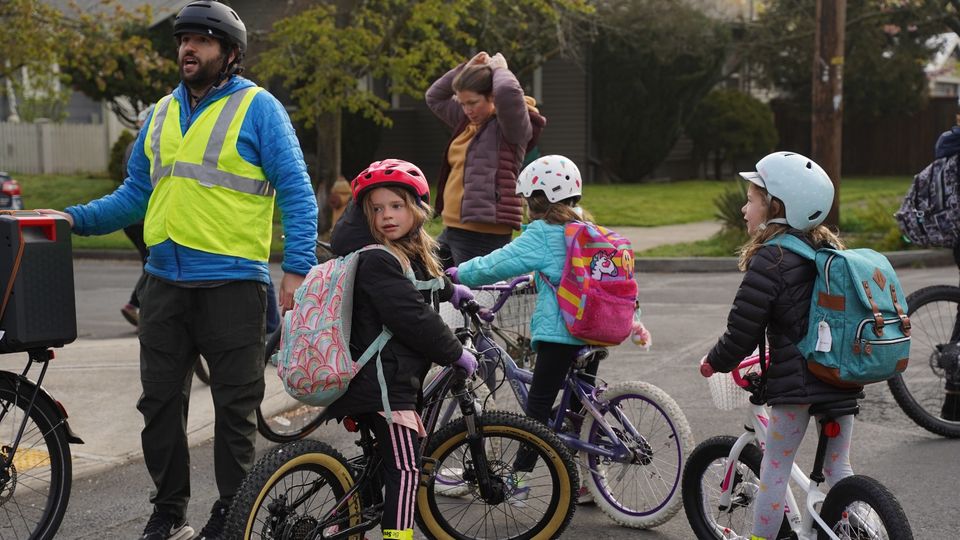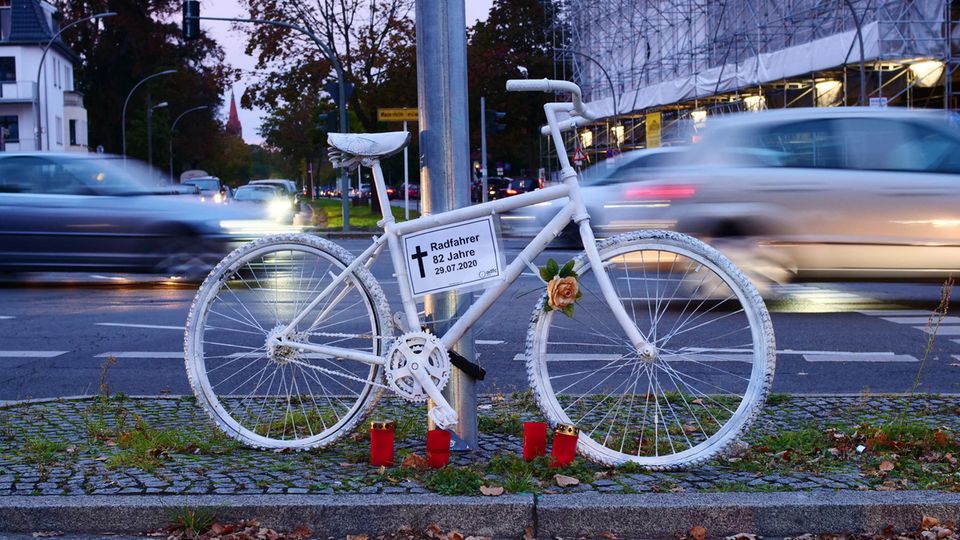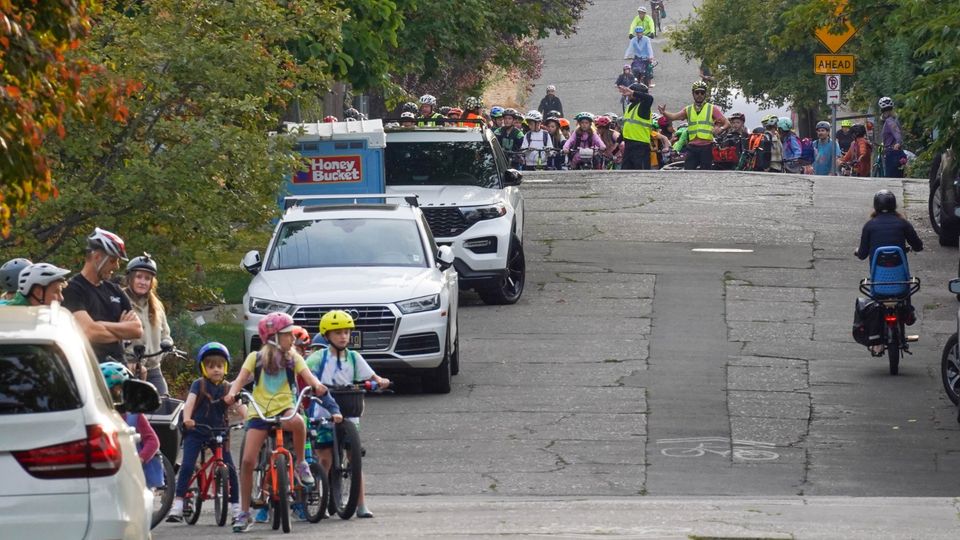Every week, physical education teacher Sam Balto organizes a so-called “Bike Bus” with which around 170 children from Portland in the US state of Oregon cycle to elementary school together. The initiative has not only revolutionized the way to school, but has also sparked global interest in innovative solutions for safe school transport.
Every Wednesday morning in Portland, people gather at their windows and doors to cheer on a group of about 170 children as they ride by on their bikes. The spectators cheer and take photos.
Physical education teacher Sam Balto leads the children on their way to school together. He wears a neon-colored safety vest and plays a mixture of new hits and tried-and-tested pop music classics to the group via a portable speaker. “Cycling offers children a sense of freedom, independence and joy,” Sam Balto tells the star. He brought the Bike Bus (German: Fahrradbus) into being.
While before the bike bus was introduced, the children were driven to school by their parents, they now ride their bikes to Alameda Elementary School as a matter of course. Not only do the students benefit from the physical exercise, the residential community is also convinced by the Bike Bus because it reduces traffic jams and pollution from buses and cars, says Sam Balto in an interview.
Bicycle infrastructure and mobility in the USA
Balto, a native of Maryland, has worked as a physical education teacher in schools across the country for over a decade. He describes himself as a passionate cyclist. While teaching in Boston, he started a “pedestrian bus” to school in 2016. He planned a safe route and encouraged students, parents, teachers and community members to join a group walk to school. “Children just love being outside with their school friends . The Pedestrian Bus and Bike Bus are also a great way to support students who do not have a parent who can safely walk or bike to school with them.”
In the United States, most people prefer cars for their daily commutes, with public transportation such as buses and trains being widely used, especially in densely populated areas and metropolitan areas such as New York City, Chicago, and San Francisco. Nevertheless, public transport is generally less common compared to cars. Usage varies greatly by region and transportation system, according to analysis by the American Public Transportation Association.
While some cities have well-developed cycle paths and lanes, others lack adequate infrastructure. At the policy level, there are efforts to improve bike-friendliness, but challenges remain such as inadequate paths and safety concerns for cyclists. “There is a strong movement in American society to make cities more bike-friendly, but progress is slower than hoped,” explains Sam Balto. He has long recognized the Bike Bus as an effective medium for generating interest in investments in bicycle infrastructure on social media. “The fact that the Bike Bus brings so much joy draws attention. It also highlights the need for safer cycling infrastructure and calls on our politicians to recognize what action they need to take for our children and their future, and the “Prioritize improving their mobility”.

Sam Balto (left) started the Bike Bus in Portland. Every Wednesday morning he leads the drives to school.
© Jonathan Maus / Bike Portland
How the Bike Bus promotes environmental awareness
“There’s a ton of research on the importance of physical activity before school,” Balto says, adding that he and his colleagues note that morning exercise improves students’ ability to concentrate in class. This impression is confirmed by research results from a study at the Technical University of Munich, which examined the connection between physical fitness, concentration and the health-related quality of life of primary school children. But what impresses Sam Balto most about the Bike Bus is how it has strengthened the school’s sense of community. “By giving children more opportunities to connect with each other, we increase their enthusiasm,” he said. “In doing so, we promote the development of resilient, close-knit and safer school communities.”
The Bike Bus was also an opportunity for students to learn about climate change. “This turned out to be a really cool, actionable element for kids and adults,” Balto says. A developed bicycle infrastructure and the promotion of cycling make a significant contribution to reducing greenhouse gas emissions by reducing the proportion of private transport. They also reduce air pollution, which in turn improves public health.
Accident-free: This is how the Bike Bus works
Sam Balto organized the first ride of the bike bus in April 2022. He initially only expected a few students who wanted to join the bike ride to school. Surprisingly, 75 children came straight away, many accompanied by their parents, to help. “Bicycling offers a sense of freedom and joy that I didn’t expect,” he noted. Given its success, he decided to continue the campaign regularly. So it became a weekly Wednesday ritual at Alameda Elementary School, and now more than 170 children meet regularly. This corresponds to around 30 percent of the entire student population.
At 8 a.m., the children and parent volunteers will gather at two different meeting points in the community. Balto has devised two routes, each about 2.5 kilometers long. The groups then meet in the middle of the route and drive the rest of the way to school together. Some of the parents wait at the main intersections to stop the bike bus until there is a gap in the car traffic and the bike bus can pass safely. “The community volunteers ensure that all children are safe and there are no traffic accidents,” explains Balto. Alameda Elementary School provides bicycles for any student who does not have their own. Local cycling organizations also support students in need by providing bikes to ensure everyone has the opportunity to ride the Bike Bus to school.
Parent volunteers wait at the main intersections to stop the bike bus until there is a gap in the car traffic and the bike bus can pass safely.
© Jonathan Maus / Bike Portland
The Bike Bus as a pioneer of a global movement
“My goal is to create more awareness about safe transport and also change the way we finance student transport at a political level,” explains Sam Balto, adding that relying on parent volunteers is actually unsustainable to carry out the Bike Bus. “Just as we have infrastructure for buses, we need to create infrastructure for bicycles.”
Since the bike bus project began, Balto has noticed groups of students riding to school together on days other than Wednesday. He constantly gets questions about the organization from other teachers, parents and schools from the USA, but also from other parts of the world. Sam Balto is currently setting up a Bike Bus organization to support other schools with the implementation. In Germany, too, more and more initiatives are emerging based on the Bike Bus model. Particularly in cities like Frankfurt and Berlin, primary school students should be made aware of traffic in the big city by traveling to school together.
10 pictures
The Bike Bus concept has not only changed the way children get to school, but has also sparked global interest in new, innovative student transport solutions. It shows how a small idea can change the lives of children around the world.
Sources: Study from the Technical University of Munich on the connection between physical fitness and concentrationAnalysis by the American Public Transportation Association



